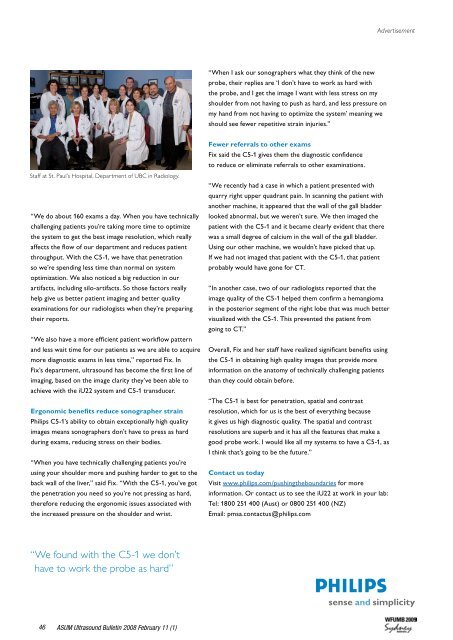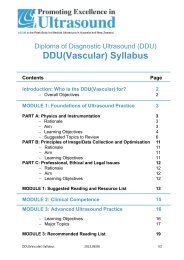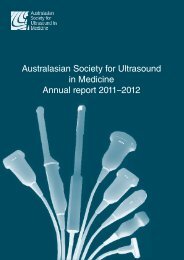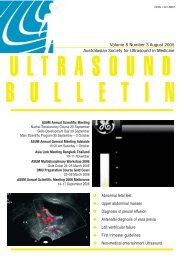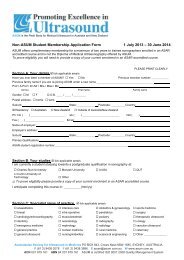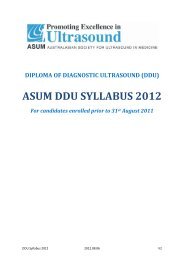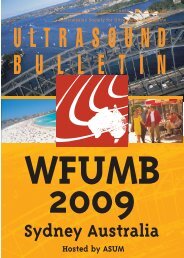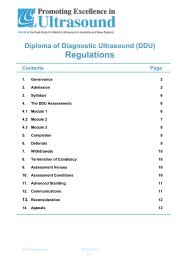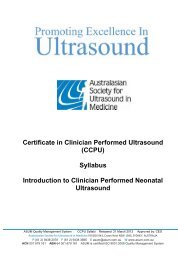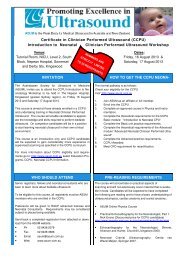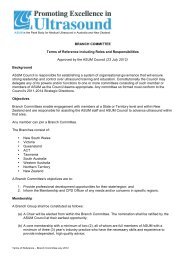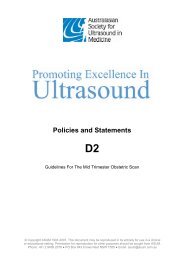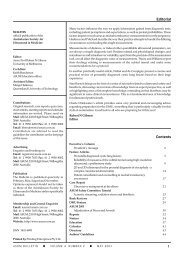Volume 11 Issue 1 (February) - Australasian Society for Ultrasound ...
Volume 11 Issue 1 (February) - Australasian Society for Ultrasound ...
Volume 11 Issue 1 (February) - Australasian Society for Ultrasound ...
You also want an ePaper? Increase the reach of your titles
YUMPU automatically turns print PDFs into web optimized ePapers that Google loves.
Advertisement<br />
“When I ask our sonographers what they think of the new<br />
probe, their replies are ‘I don’t have to work as hard with<br />
the probe, and I get the image I want with less stress on my<br />
shoulder from not having to push as hard, and less pressure on<br />
my hand from not having to optimize the system’ meaning we<br />
should see fewer repetitive strain injuries.”<br />
Staff at St. Paul’s Hospital, Department of UBC in Radiology.<br />
“We do about 160 exams a day. When you have technically<br />
challenging patients you’re taking more time to optimize<br />
the system to get the best image resolution, which really<br />
affects the flow of our department and reduces patient<br />
throughput. With the C5-1, we have that penetration<br />
so we’re spending less time than normal on system<br />
optimization. We also noticed a big reduction in our<br />
artifacts, including silo-artifacts. So those factors really<br />
help give us better patient imaging and better quality<br />
examinations <strong>for</strong> our radiologists when they’re preparing<br />
their reports.<br />
“We also have a more efficient patient workflow pattern<br />
and less wait time <strong>for</strong> our patients as we are able to acquire<br />
more diagnostic exams in less time,” reported Fix. In<br />
Fix’s department, ultrasound has become the first line of<br />
imaging, based on the image clarity they’ve been able to<br />
achieve with the iU22 system and C5-1 transducer.<br />
Ergonomic benefits reduce sonographer strain<br />
Philips C5-1’s ability to obtain exceptionally high quality<br />
images means sonographers don’t have to press as hard<br />
during exams, reducing stress on their bodies.<br />
“When you have technically challenging patients you’re<br />
using your shoulder more and pushing harder to get to the<br />
back wall of the liver,” said Fix. “With the C5-1, you’ve got<br />
the penetration you need so you’re not pressing as hard,<br />
there<strong>for</strong>e reducing the ergonomic issues associated with<br />
the increased pressure on the shoulder and wrist.<br />
Fewer referrals to other exams<br />
Fix said the C5-1 gives them the diagnostic confidence<br />
to reduce or eliminate referrals to other examinations.<br />
“We recently had a case in which a patient presented with<br />
quarry right upper quadrant pain. In scanning the patient with<br />
another machine, it appeared that the wall of the gall bladder<br />
looked abnormal, but we weren’t sure. We then imaged the<br />
patient with the C5-1 and it became clearly evident that there<br />
was a small degree of calcium in the wall of the gall bladder.<br />
Using our other machine, we wouldn’t have picked that up.<br />
If we had not imaged that patient with the C5-1, that patient<br />
probably would have gone <strong>for</strong> CT.<br />
“In another case, two of our radiologists reported that the<br />
image quality of the C5-1 helped them confirm a hemangioma<br />
in the posterior segment of the right lobe that was much better<br />
visualized with the C5-1. This prevented the patient from<br />
going to CT.”<br />
Overall, Fix and her staff have realized significant benefits using<br />
the C5-1 in obtaining high quality images that provide more<br />
in<strong>for</strong>mation on the anatomy of technically challenging patients<br />
than they could obtain be<strong>for</strong>e.<br />
“The C5-1 is best <strong>for</strong> penetration, spatial and contrast<br />
resolution, which <strong>for</strong> us is the best of everything because<br />
it gives us high diagnostic quality. The spatial and contrast<br />
resolutions are superb and it has all the features that make a<br />
good probe work. I would like all my systems to have a C5-1, as<br />
I think that’s going to be the future.”<br />
Contact us today<br />
Visit www.philips.com/pushingtheboundaries <strong>for</strong> more<br />
in<strong>for</strong>mation. Or contact us to see the iU22 at work in your lab:<br />
Tel: 1800 251 400 (Aust) or 0800 251 400 (NZ)<br />
Email: pmsa.contactus@philips.com<br />
“We found with the C5-1 we don’t<br />
have to work the probe as hard”<br />
46 ASUM <strong>Ultrasound</strong> Bulletin 2008 <strong>February</strong> <strong>11</strong> (1)


